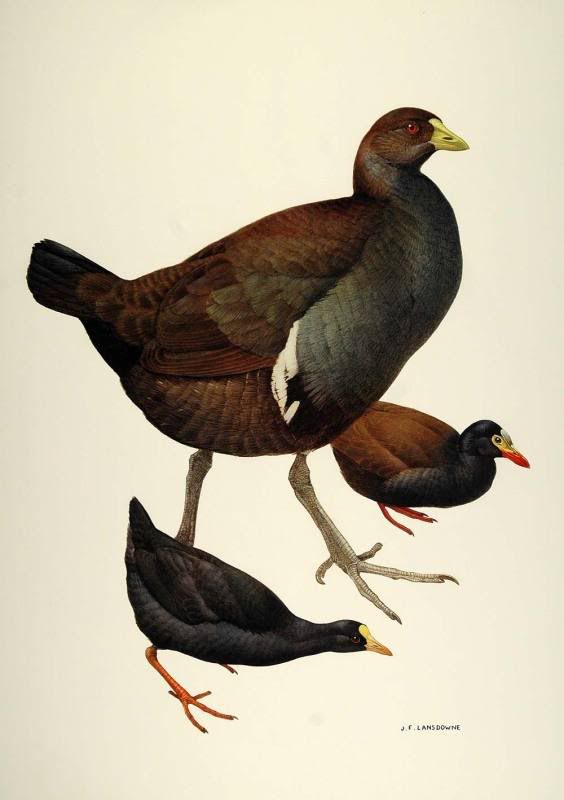|
|
Post by another specialist on Dec 9, 2008 13:15:10 GMT
1984 Print Lansdowne  This is an original 1984 color print of three rails: the Tasmanian Native Hen (upper center), also called "Narkies"; the San Cristobal Gallinule (middle right), a rare bird --the only known specimen was obtained in 1929 on San Cristobal Island in the Solomon Islands; and the Samoan Wood Rail (bottom), a small flightless rail, probably extinct, no record of it since 1873, known only from the Solomon Islands. Original on sale at ebay. |
|
|
|
Post by another specialist on Sept 23, 2012 15:33:28 GMT
|
|
|
|
Post by Sebbe on Jan 31, 2015 5:36:09 GMT
|
|
|
|
Post by Sebbe on Jan 31, 2015 5:52:30 GMT
|
|
|
|
Post by koeiyabe on Nov 28, 2015 17:09:52 GMT
 left below "Living Things Vanished from the Earth (in Japanese)" by Toshio Inomata (1993) with Bay Thrush(?), Tahiti rail, Tahitian Sandpiper, Choiseul Pigeon (clockwise). |
|
|
|
Post by Melanie on Jul 5, 2016 17:28:17 GMT
Article Citation: H. Douglas Pratt and John C. Mittermeier (2016) Notes on the natural history, taxonomy, and conservation of the endemic avifauna of the Samoan Archipelago. The Wilson Journal of Ornithology: June 2016, Vol. 128, No. 2, pp. 217-241. MAJOR ARTICLES Notes on the natural history, taxonomy, and conservation of the endemic avifauna of the Samoan Archipelago H. Douglas Pratt1,4 and John C. Mittermeier2,3 1 North Carolina Museum of Natural Sciences, 11 West Jones Street, Raleigh, NC 27601, USA. 2 Museum of Natural Science and Department of Biological Sciences, 119 Foster Hall, Louisiana State University, Baton Rouge, LA 70803, USA. 3 School of Geography and the Environment, University of Oxford, South Parks Road, Oxford, OX1 3QY, United Kingdom. 4 Corresponding author; e-mail: dpratt14@nc.rr.com ABSTRACT The Samoan Archipelago is an important area of avian diversity and endemism within the tropical Pacific. Here, we summarize observations on the natural history and vocalizations of Samoan birds based on fieldwork conducted over the course of five visits to Samoa and American Samoa from 1977 to 2006 with particular emphasis on the Manu’a Islands and the highlands of Savai’i. We interpret our findings in light of modern understanding of the biological species concept to identify seven Samoan forms as previously unrecognized endemic species: Samoan Wood Pigeon Columba [vitiensis] castaneiceps, Peale’s Kingfisher Todiramphus [chloris] pealei + manuae, Manu’a Shrikebill Clytorhynchus [vitiensis] powelli, Samoan Myzomela Myzomela [cardinalis] nigriventris, Samoan Robin Petroica [multicolor] pusilla, Manu’a Starling Aplonis [tabuensis] manuae, and Samoan Thrush Turdus [poliocephalus] samoensis. The number of endemic species in the archipelago thus increases from 10 to 17. Field surveys on Savai’i reveal significant differences between highland and lowland bird communities, with several lowland species reaching their upper elevational limit at 1,200 m. We conclude that the critically endangered Samoan Woodhen Gallinula pacifica has been extinct for over a century, and suggest that recent reports are based on misidentifications. We found the Tooth-billed Pigeon Didunculus strigirostris to be Critically Endangered and in urgent need of conservation action. www.bioone.org/doi/abs/10.1676/wils-128-02-217-241.1 |
|
|
|
Post by Melanie on Jul 5, 2016 17:29:28 GMT
Is Samoan Moorhen extinct? 5 Jul 2016 - 18:37 -- Chris Sharpe Samoan Moorhen (Pareudiastes pacificus), a species known from three skins and an egg, has not been recorded with certainty since 1873. Locals on its island home of Savai'i claim that the bird was extinct by 1907, and it was considered so until unconfirmed sightings in 1984 and 2003 sparked hope that it may have persisted in remote montane forests. Nevertheless, a 17-day targeted search in Jun–Aug 2005 failed to find the species, as did a two-day visit in Nov of the same year; likewise, 2012 surveys proved fruitless. A re-evaluation of the sight records finds them to be unconvincing. The fieldworkers conclude that the species is now very likely extinct, joining the 500–1600 species of flightless rails that inhabited Pacific islands prior to the arrival of the first humans. www.hbw.com/news/samoan-moorhen-extinct |
|